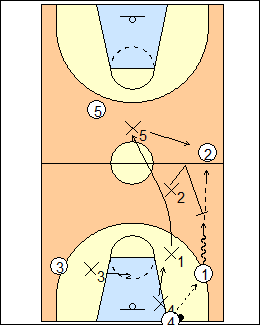Run and jump fullcourt
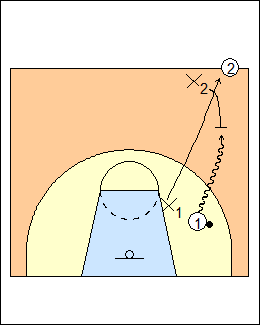 | 1 A run-and-jump press is used against teams that dribble the ball up the floor, a defender jumps into the path of a ballhandler dribbling at high speed, the original defender continues to pick up an open player. Run and jump takes advantage of poor ballhandlers, promotes up-tempo play, teaches skills such as switching and finding open players, and can be effective as a surprise manoeuvre, but easy baskets can be allowed if the offence stays under control and passes the ball well. Here X1 forces the dribbler sideline. X2 releases from 2 when the ballhandler is three strides away and jumps into 1's path towards his outside shoulder. When X2 reaches 1, X1 runs through to pick up 2 (X2 can yell "jump" or "go" to signal that X1 should jump switch). Because this is a two-player tactic, there is no rotation or adjustment by the other defenders. These situations can be practiced in breakdown drills, e.g., 2-on-2, with the option of doing 2 or 3 run and jumps fullcourt before the offence tries to score, see Pressing - 2 on 2 fullcourt, Run and jump. Jump switching is most effective if combined with trapping, and fake trapping. A trap-and-rotate press is a logical progression and companion, see Defences - White and black match-up press, Florida match-up press, Hoop Tactics. |
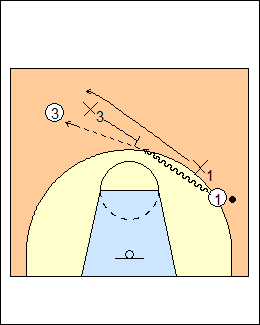 | 2 Trapping is often done only along the sidelines, but run and jump switch can be done in the middle of the floor. Here 1 is speed dribbling at X3, who sprints at 1 and the contains the ball, if 1 passes to 3 the defenders switch. If 1 stops the dribble, X1 and X3 will trap (run and double), if 1 passes out of the trap to 3, it becomes a run and jump, with X1 taking 3. Vance Walberg - trap if 1 drives up the sideline or the middle, X3 can't get gapped, i.e., let 1 split him and X1. If 1 passes in the air off the dribble to 3, X1 runs and jumps; if 1 stops, trap him. Patrick Hunt - run and jump when the dribbler has his head down, is out of control, or spin dribbles, if in doubt, fake and recover. They don't like to jump switch when the ball is in the middle, help and recover to slow down the dribbler. Rick Pitino - trap or jump any uncontrolled sideline or middle dribble, they can also fake a trap on the sideline (hedge and recover). See Defence - 2-2-1 Walberg, Pressing - Patrick Hunt. |
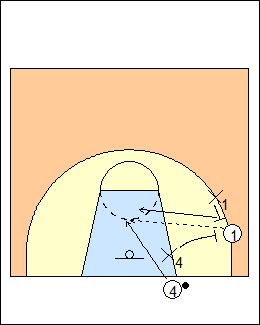 | 3 Here X4 and X1 quick trap 1 on the inbounds pass. On an immediate pass to 4, X1 jump switches with X4, whose momentum and vision are away from the ball. Australia - the player who sees the pass leaves the trap and rotates onto the attacker. As a breakdown drill, the defenders can sprint out of the trap to pursue dribbler 4 if the pass is completed. Run another group coming back on the other side. |
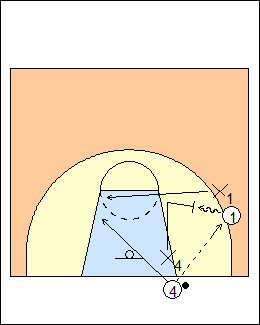 | 4 Here X4 drops back to the level of the ball on the inbounds pass, then runs and jumps as 1 dribbles towards the middle. X1 takes 4. X4 could optionally fake a trap and recover to 4. Variation - to practice double teaming, X1 forces 1 to dribble up the sideline, sprints in front to cut him off, then X4 traps from the side. |
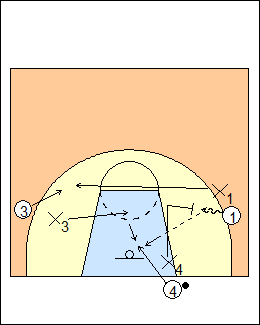 | 5 Here there is a 3-man rotation. X4 again drops to the level of the ball on the inbounds pass, and runs and jumps when 1 dribbles middle. X3, who jumped to a splitline help position on the inbounds pass, takes inbounder 4 on a return pass from 1. X1 rotates to pick up 3. If X1 and X4 trap 1, X3 will shoot the gap looking to intercept a pass back to 4. If 1 passes out of the trap to 3, X1 picks him up. X4 could optionally look to be an interceptor in the middle instead of running at 1, then take the ball if a pass is made back to the inbounder. |
This page was made with Basketball playbook from Jes-Soft
